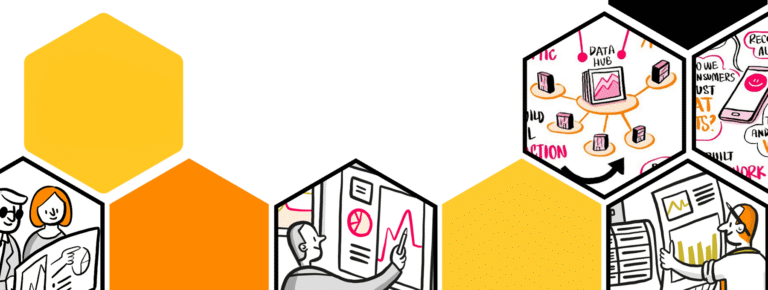What is Customer Journey Analytics?
Customer Journey Analytics is more than just a buzzword; it’s the GPS for your customer’s interactions with your brand. Imagine having a bird’s-eye view of every touchpoint your customer interacts with—a social media ad, an in-store visit, or a customer service call. Customer Journey Analytics allows you to map out these interactions, analyze them, and use data-driven insights to optimize each stage of the customer journey. It’s like having a roadmap that tells you not just where your customers are, but also how they feel and what they want at each stage. In the age of Big Data, Customer Journey Analytics is the analytical tool that lets you sift through the noise and focus on what truly matters: the customer. It’s the lens through which you can view the effectiveness of your marketing strategies, the quality of your customer service, and the overall health of your customer relationships.
TABLE OF CONTENTS
- What is Customer Journey Analytics?
- Why is Customer Journey Analytics so important?
- What is a CDP Platform?
- 5 ways of mastering your Customer Journey Analytics with a CDP
- How Vaimo can help
Why is Customer Journey Analytics so important?
In today’s hyper-connected, ultra-competitive market, 86% of consumers would leave a brand after as few as two poor experiences.1 You read that right: your audience is less forgiving than ever. They expect seamless, personalized experiences across all channels—online and offline. Fail to deliver, and they’ll switch to your competitor without a second thought. That’s why Customer Journey Analytics is not just a “nice-to-have”; it’s a “must-have” strategic asset. It helps you identify pain points in the customer journey, optimize touchpoints, and ultimately, drive conversions and loyalty. In a world where customer expectations are sky-high, Customer Journey Analytics is your secret weapon for customer retention and brand differentiation. It’s the cornerstone of a customer-centric strategy, enabling you to move from reactive problem-solving to proactive experience design. With Customer Journey Analytics, you’re not just putting out fires; you’re building a resilient, customer-centric organization that’s primed for long-term success.
What is a CDP Platform?
Now, let’s talk about the powerhouse that makes all this possible—the Customer Data Platform (CDP). A CDP is not just another data storage solution; it’s a dynamic, real-time engine that unifies customer data from multiple sources into a single, actionable view. Unlike traditional CRM or DMP systems, a CDP is designed to collect, process, and integrate data from all touchpoints, be it your website, mobile app, customer service, or in-store interactions. This unified data model enables real-time decision-making and hyper-personalized customer interactions across all channels. It’s the backbone of your data-driven marketing strategy, providing a centralized hub for all your customer data, which different departments within your organization can easily access and utilize. With a CDP, you’re not just collecting data; you’re turning it into a strategic asset that drives customer engagement, boosts sales, and enhances brand loyalty.
5 ways of mastering your Customer Journey Analytics with a CDP
#1: Unifying your data
The first step in mastering Customer Journey Analytics is to break down the data silos within your organization. A CDP excels at consolidating data from various touchpoints—social media, ecommerce platforms, CRM systems, and even offline channels—into a unified customer profile. This 360-degree view not only enables you to deliver personalized experiences but also provides rich insights into customer behavior, preferences, and lifetime value. It’s the foundation upon which you can build targeted marketing campaigns, personalized content, and customer-centric services. With a unified data model, you’re not just aggregating data; you’re creating a single source of truth that empowers your entire organization.
#2: Allowing for real-time analytics
In today’s fast-paced digital landscape, timing is everything. A CDP enables (near-) real-time analytics, allowing you to react to customer behavior as it happens. Imagine being able to send a targeted email or adjust an ad campaign in real time based on customer interactions. This level of agility can significantly boost your conversion rates and enhance customer satisfaction. It’s like having a real-time feedback loop that informs your marketing decisions, ensuring you’re always in sync with your customer’s needs and preferences. With real-time analytics, you’re not just reacting to customer behavior; you’re anticipating it, enabling you to deliver truly relevant experiences to your audience.
#3: Segment like a pro
One size doesn’t fit all when it comes to customer engagement. A CDP allows you to segment your audience based on various factors—behavioral patterns, demographic data, purchase history, and even predictive analytics. By tailoring your messaging and campaigns to different customer segments, you can dramatically improve engagement rates, ROI, and customer lifetime value. It’s the key to moving beyond generic, one-size-fits-all marketing and towards truly personalized customer experiences. With advanced segmentation capabilities, you can create highly targeted campaigns that resonate with specific customer groups, driving higher engagement and conversion rates.
#4: Optimize multi-channel marketing
Your customers are everywhere—on social media, browsing your website, visiting your physical stores—and your marketing efforts must be just as omnipresent. A CDP enables you to orchestrate multi-channel campaigns that are not only consistent but also complementary. This ensures that your brand message is coherent and impactful, regardless of the channel or platform. It’s about creating a seamless customer journey that transcends individual touchpoints and provides a unified brand experience. With a CDP, you can coordinate your marketing efforts across multiple channels, ensuring that your messaging is consistent, relevant, and engaging, no matter where your customers are.
#5: Measure, tweak, repeat
The beauty of Customer Journey Analytics is that it’s an ongoing process. A CDP facilitates continuous monitoring of key performance indicators (KPIs), customer feedback, and other metrics from across the whole customer journey. This iterative approach enables you to refine your strategies, optimize campaigns, and stay ahead of customer expectations. It’s not just about setting and forgetting; it’s about constantly evolving your customer journey strategies to meet and exceed expectations. It’s about adopting a culture of continuous improvement, where every customer interaction is an opportunity to learn, adapt, and enhance. With a CDP, you can track the effectiveness of your marketing campaigns, measure customer satisfaction, and identify areas for improvement, enabling you to make data-driven decisions that drive long-term success.
There you have it—five actionable ways to leverage a CDP for superior Customer Journey Analytics.
The future of customer experience is data-driven, and the data confirms it. Between 2021 and 2022, CDP market revenues increased by 25%, reaching $2 billion. If the same trend continues, the market will be reaching $2.5 billion by the end of 2023.2 Adopting a CDP platform and leveraging those insights is not allowing you “just to keep pace” with customer expectations. It’s setting the standard for what a truly customer-centric brand should be.
How Vaimo can help
With more than 15 years of experience in ecommerce, experience management, and customer data-driven optimizations, we can help you unlock the full potential for driving business results by optimally using your customer data.
We guide you in clarifying your vision and ambitions and defining the key use cases; we guide you in evaluating and selecting the right solution and future-proof martech and data infrastructure. We develop a comprehensive data strategy, ensuring data governance and compliance with a realistic roadmap for success.
By providing continuous support and empowerment, we help you optimize your customers’ experience across their whole journey through actionable insights and real-time triggers. In parallel, we ensure your data strategy stays up-to-date and aligns with your evolving business needs.
Are you happy with your customer data strategy? Take our free customer data assessment to find out where you stand.
Sources
2 – The 30+ most important CDP market stats to know in 2023 – lytics.com







